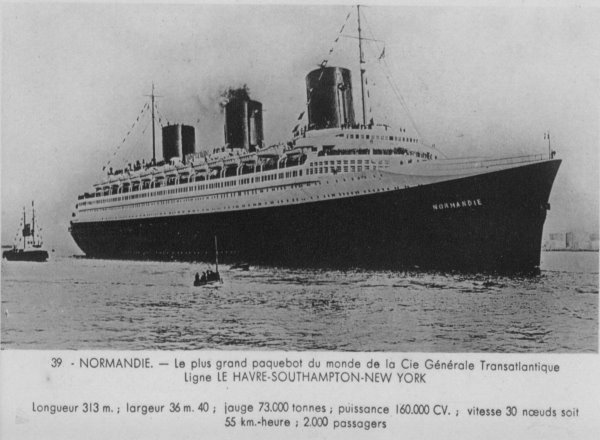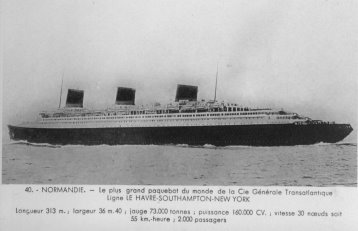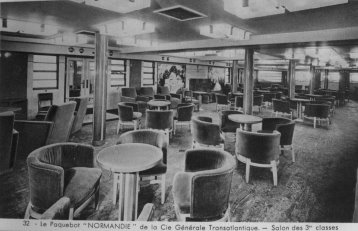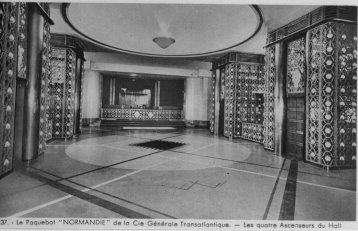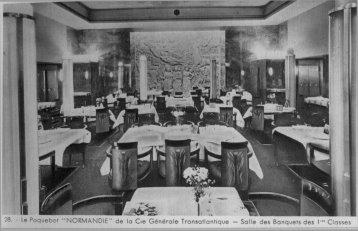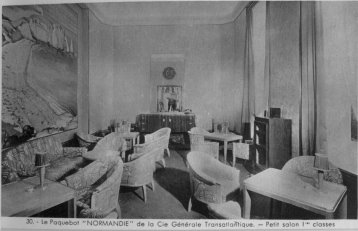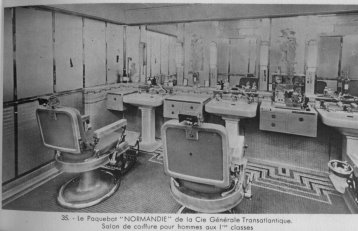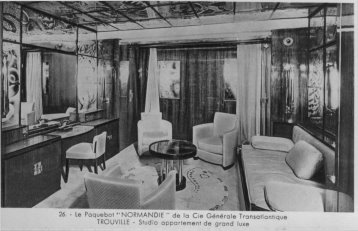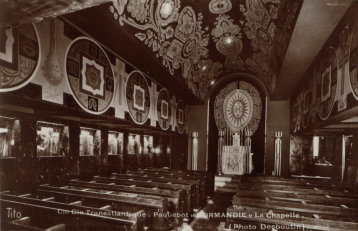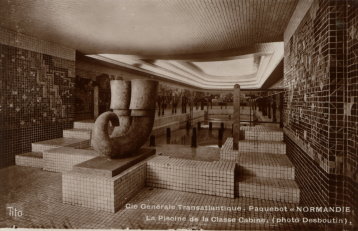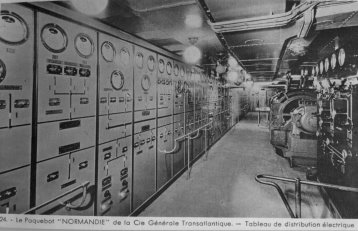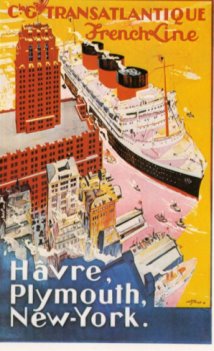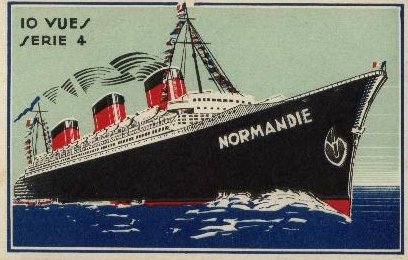
The SS Normandie
|
The Normandie was built by the French Line at St. Nazaire. She was completed three years after the Wall Street Crash (29th October 1929). On the 29th October 1932, 200,000 people witnessed the launch of the great ship into the Loire River . MME Albert Lebrun, the French President's wife, christened the ship with champagne. The Normandie was the first ship to exceed 1000 feet in length. She was the largest ship afloat.
Her design and looks made her extremely hydrodynamic. When sailing she produced little bow wave and only left a thin flat wake (behind her). Small boats sailing near the ship suffered little from her ripple waves. Often was the case with big liners that the waves caused by the huge propellers would toss smaller vessels around. The Normandie changed this, much to the pleasure of local fishermen.
She was built was three funnels each one was slightly smaller than the other, again giving her superior hydrodynamics compared to other liners. Her maiden voyage was scheduled for 1934 but was delayed until May 1935. There had been a rapid decline in passenger traffic, perhaps due to the Wall Street Crash in 1929 and the economic crisis that followed.
The French Line did not want the Normandie floating in her mooring indefinitely and so entered into a period of celebrations onboard. For three days the Normandie hosted dinners, galas and parties for over 1000 guests. The ship and her grandeur were heavily publicized by local, national and international press. On the 29th May 1935 at 5 pm the Normandie departed for her maiden voyage. She crossed the English Channel to Southampton . As passengers looked around the ship they must have been impressed by the amount of space which was afforded on the decks and inside the ship.
The first class dining room illustrates the luscious spaciousness of the ship. The room was 305 feet long and 45 feet wide with a coffered ceiling 26 feet high. It provided space for 150 tables with places for all first class passengers so that dinner could be served at 8 pm together in one sitting. There was a theatre onboard. After dinner many quests would go to the theatre to be entertained. In modern Cruise Liners entertainment plays a huge part in the daily schedule of events. Cabarets are normal. The Normandie was the first ocean liner to accommodate entertainment in this way. The theatre doubled up as a live stage as well as a cinema.
The Café grill opened on the 1st June 1935. It offered an A La Carte restaurant, night-club and bar. It was a very popular venue for passengers who wanted to carry the night on after the theatre. It opened in to the small hours of the morning.
The Normandie was renowned for its spacious accommodation. She could berth a total of 1,972 passengers: 864 1st class or cabin class; 654 2nd class passengers or Tourism class; and 454 third class passengers
As well as the usual dining room, saloons, and shops, there was a winter garden on thre Promenade deck. It had fountains and live exotic birds. There was a library which boasted over 5000 books and also had the largest swimming pool her passengers had ever seen on an ocean liner.
On the 2nd June 1934 the Normandie approached the Ambrose Lighthouse. The lighthouse marked the end of the Atlantic crossing. Normandie had crossed a 3000 mile distance in just four days, 3 hours and 2 minutes. She had averaged 30 knots during the crossing. On her return journey she captured the Blue Riband.
For the next four years there would be a battle between the RMS Queen Mary and the Normandie in capturing the Blue Riband. The Outbreak of the Second World War interrupted the service of many Atlantic crossings. The French Line also suffered. The Queens and the Normandie was moored together on their respective piers in New York for a period of three weeks. The Queen Elizabeth joined the Queen Mary and the Normandie in March 1940. The Normandie was requisitioned by the US Navy following the invasion of Pearl Harbor. By December 1941 the Normandie had started to be refurbished to become a troopship. Her lavish interiors were stripped and stored in a warehouse in New York. Her refurbishment would prove to be a disaster. The Fire that destroyed the ship On the 9th February 1942, a fire started in the grad saloon. Workmen were removing the last of the metal stanchions that had supported the glass fountains of light when a spark from the cutters blowtorch landed on a highly flammable kapok filled lifejacket. Soon the fire had spread with a vengeance. Since the Normandie was being stripped to become the troopship Lafayette, most of the safety features (telephones, fire alarms, water pumps etc) had been disassembled. The ship was defenceless. The New York fire department was not called until twelve minutes after the fire had started. The highly flammable bales caught fire instantly. There were 3000 workers onboard at the time all working on the transformation. They had to be evacuated before action by the authorities could commence. The fire brigade, although doing their job, exacerbated the problem facing the Normandie. Fireboats and firemen were filling the ship with so much water that a severe portside list developed. Water started tom pour in through the cargo doors that were still open. During the night, the Normandie turned onto her side. She would remain in this position for the next eighteen months until the US government had carried out no less than 6 investigations as to who was to blame for the accident. The US Navy thought that a salvage operation would prove to be invaluable and if successful would still possess a 1000 foot troopship after repairs. Unfortunately, after a $4.74 million salvage operation it became clear that the hull had suffered extensive damage and would beyond economic repair. The Normandie was sold for scrap and the fixtures and fittings stored in the warehouse were auctioned off. Another life of a great liner was taken.
|
